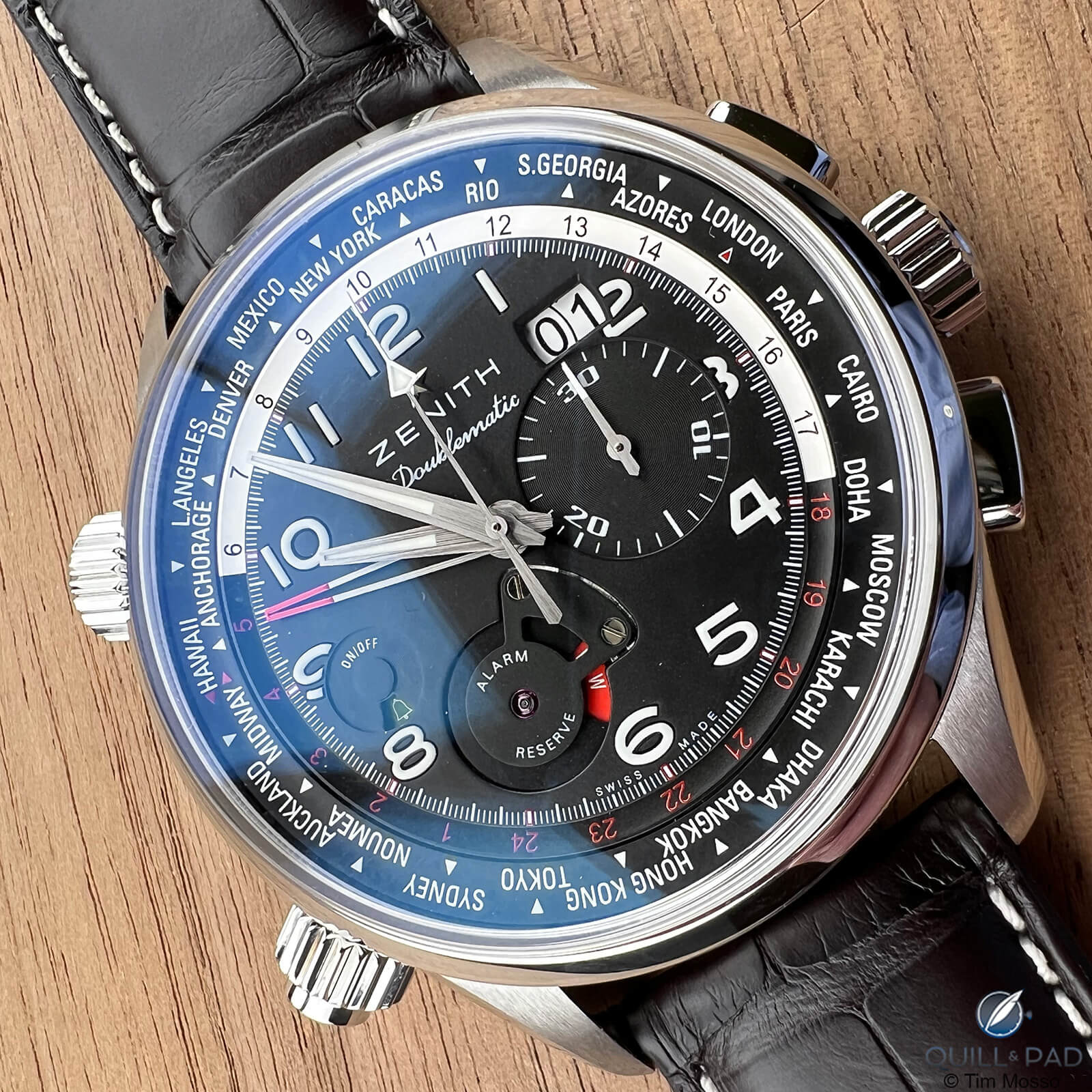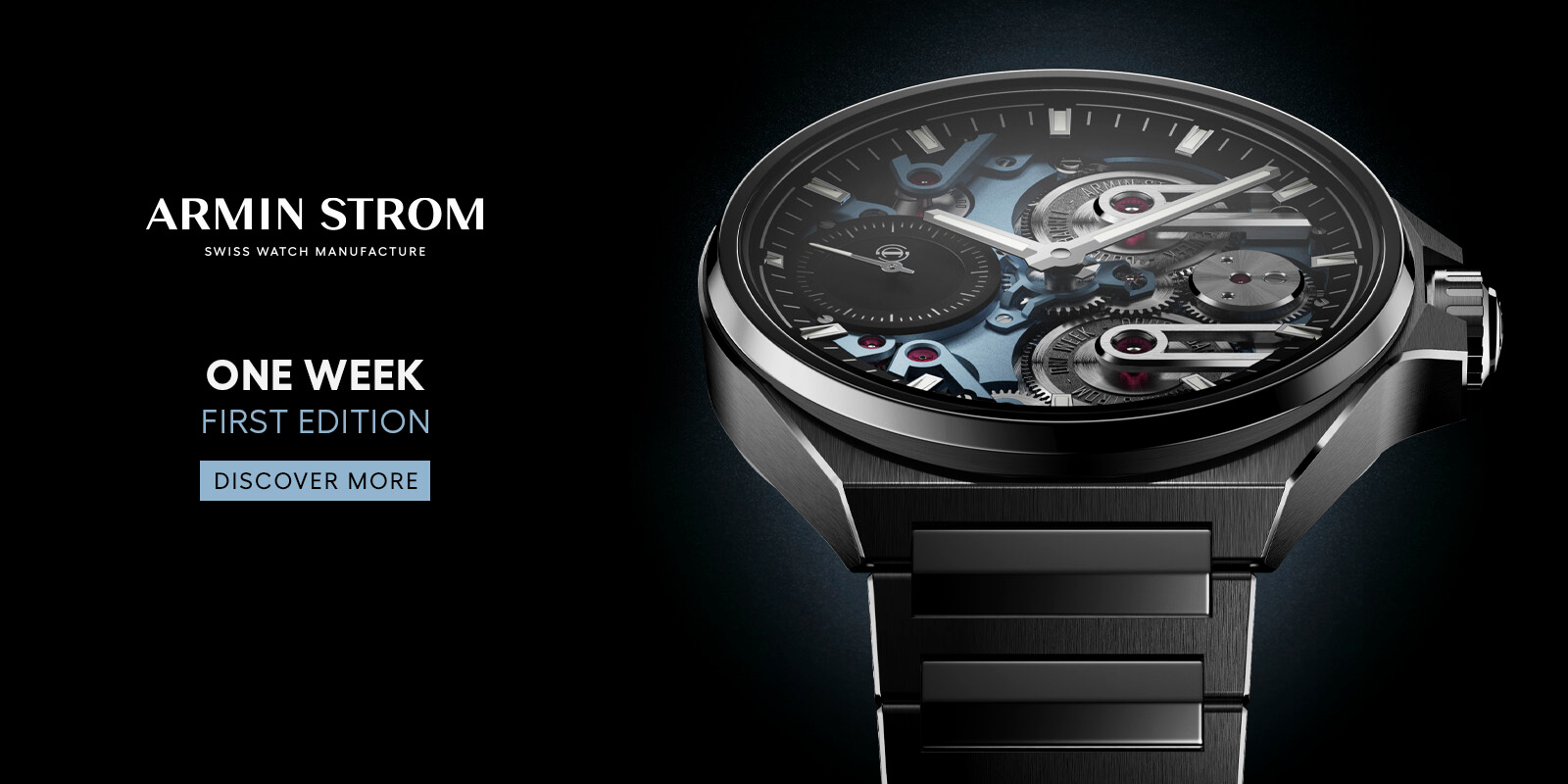Zenith Pilot Doublematic Reviewed by Tim Mosso: It’s a Grail Watch for him (if only he had a Bigger Wrist)
by Tim Mosso
The phrase “grail watch” has been in the lexicon for as long as I’ve been in the watch hobby. There’s some dispute about whether a “true” grail-level goal should be attainable or not, but all definitions seem to revolve around money.
What if the prohibitive dream watch were eminently affordable to attain but too large to wield? Is that a grail?
If so, behold my grail watch, the Zenith Pilot Doublematic.

Zenith Pilot Doublematic
Launched in 2012, the Doublematic was an undercard release amid that year’s bumper crop of Zenith pilot’s watches. The monster 5011K-powered Pilot Montre d’Aeronef Type 20 sucked up the oxygen with its 57.5mm grandeur and new-old-stock COSC pocket watch caliber.
At lower price points, affordable miniatures of the Type 20 style fleshed out the line. The Doublematic was the neglected middle child between press coverage of the top and bottom of the lineup.

Zenith Pilot Doublematic
Like many of the watches launched under Jean-Frédéric Dufour, the Doublematic had engineering roots preceding his tenure but sported the restrained design cues that were his signature. Following the reign of Thierry Nataf, many of movements designed under his leadership found their way into Dufour’s brand of classically handsome packages.
Nataf’s excesses were legendary, and, to paraphrase REO Speedwagon, these tales grow taller on down the line.
Despite his supervillain status among Zenith purists, Nataf did the hard work of spending on calibers that would become the foundations of memorable watches under Dufour.

Zenith Class Traveller Open Multicity
For example, behold the Nataf-era Zenith Class Traveller Open Multicity; Dufour did it better, but Nataf did it first. Give credit where credit is due.
———————————————————————————————–
———————————————————————————————–
The Doublematic isn’t a “Big Pilot’s Watch,” but it’s indisputably a big pilot’s watch.

Zenith Pilot Doublematic on the author’s wrist
At 45mm in diameter and 53.3mm from lug-to-lug, the chronograph is a massive and sprawling contraption. Sheer scale is the immutable barrier to my dreams of ownership.

Zenith Pilot Doublematic
Despite many encounters and reasonable prices, I’ve never sealed the deal because the watch looks too huge on my 16cm wrist. Check out the photos; there’s no question that I’m too small for this ride.

El Primero movement of the Zenith Pilot Doublematic
That said, this isn’t a mindlessly oversized flex from the likes of Hublot or AP. The Zenith is huge because it has a 41-jewel movement with 439 parts and eight distinct functions. Every corner of the dial is packed with information.
45mm likely was the smallest case the designers were able wrap around the hardware.
Above all, this is a Zenith El Primero chronograph. The celebrated high beat chrono has been a reference point, a fan favorite, and the beating heart of the Le Locle manufacture since its birth in 1969. While the finish of caliber 4046 is primarily mechanical and streamlined by automation, it’s attractive and thoughtful.

Zenith Pilot Doublematic
The distinct use of blue screws for adjustments and polished screws for fixed assemblies is a Zenith tradition across generations. Column wheel feel remains outstanding.
The unusually handsome caliber 4046, like all El Primeros, permits the user to see a surprising amount of chronograph hardware generally buried underneath the winding bridge of other automatic chronos.

Zenith Pilot Doublematic movement
Hammers, levers, column wheel, clutch, and wheels look great, and the winding bridge is so small that all the chrono gear can be appreciated.
Upon close inspection, many of the steel chronograph components sport a smart combination of satin on top and narrow bevels of polished steel. For a movement mostly decorated by machine, this level of attention is superb.
———————————————————————————————–
———————————————————————————————–
At 30mm in diameter, the El Primero isn’t petit, but it’s a bit overwhelmed by the sheer scale of this watch. That’s fine, because the details are captivating. Adjacent to the rotor, Zenith’s spring-and-pawl reversing wheel is a delightfully intricate assembly.

Mirror polished column wheel of the Zenith Pilot Doublematic
The column wheel’s crenelated profile is mirror-polished in a fashion commensurate to its importance.
Le Locle gilds the sink for the pivot jewel of the chronograph clutch’s intermediate wheel, and it’s a lovely nod to the bygone era of chaton cups in watchmaking.
A satin brushed lever sits astride a blue eccentric screw on the regulator assembly; the curb pin index is polished. Regulation by that eccentric screw is aided by a tiny scale with miniscule calibration marks.

Zenith Pilot Doublematic
Engine turning on the balance cock and other bridges is a unique Zenith tradition that spans generations; most constructors use Geneva waves on bridge surfaces.
Here and there, a scratch, excess lubricant, or a tool mark reveals that Zenith still employs human beings in its assembly process.
On the dial side, the El Primero’s famous 5Hz beat rate expresses itself as a smoother gliding chrono seconds hand. Against the ear, the old champion’s double-step cadence remains a charismatic chatter that’s music to Zenith fans.

Zenith Pilot Doublematic
The Doublematic surrenders its chronograph hours register to other functions, but any serious pilot in need of elapsed hours will have other recourses in the cockpit.
World time isn’t a traditional Zenith hallmark, but the company insisted upon the 2012 launch that the Doublematic was inspired by a 1950s universal time chronograph. Regardless, the modern watch incorporates a classic Louis Cottier-style circumferential city ring and a concentric 24-hour scale that moves counterclockwise.
Set one’s current city at 12 o’clock, adjust the hands to the present time, and then read the current hour on the 24-hour scale adjacent to the foreign city of interest.
Black and white semi-circles on the hour ring roughly depict regions experiencing day and night. While the system can’t deal with certain idiosyncratic time zones, it works well for most international travel, calls, and business affairs.
———————————————————————————————–
———————————————————————————————–
Zenith’s tandem of chronograph and world time has been shared by brands as disparate as Patek Philippe and Jaeger-LeCoultre, but the addition of an alarm makes this Doublematic a true original.
Wound, set, and armed with the crown at eight o’clock, the alarm sings a sweet song against a floating gong. This is no case-striking “frog” or “cricket.”
Critically, the volume is loud enough to wake a sleeping person; this is a mandatory quality for many alarm watch devotees.

Alarm on/off indication of the Zenith Pilot Doublematic
Zenith complicates the alarm through the inclusion of two supporting functions. Owners can arm or disarm the alarm using a trigger co-axial with the alarm crown; on or off status is visible in green and red, respectively, at the nine o’clock position.

Alarm power reserve indication of the Zenith Pilot Doublematic
Not only does Zenith incorporate a power reserve for the alarm barrel, but it does so with a display that orbits madly around its axis while changing from green to red. A fully charged alarm displays “FULL” on a green base while a discharged red reserve reads “LOW.”

Three dimensional lume numerals of the Zenith Pilot Doublematic
Despite its defining qualities of size and complexity, the Doublematic packs a gratifying number of delightful details. Numerals on the dial appear printed at first glance, but they are three dimensional blocks of luminant material cut in the shape of numbers.
The strap surprises on two counts. First, alligator leather is a significant upgrade over the calf skin often used on pilot’s watches.

Strap of the Zenith Pilot Doublematic
Second, the strap features a wonderfully supple rubber inlay on its underside; it’s smooth against the skin and promises to preserve the leather against sweat and grime. Beneath the crown, a tiny kerf readily admits probing fingernails when it’s time to set the machine.
Often, I’m asked whether it’s possible to own a single watch that could fulfill all needs. And just as often, I’m asked this question by precisely the kind of people who could never stop at just one watch. However, water resistance aside, the Zenith Pilot Doublematic is big enough to fill that gap in a collector’s life.

Zenith Pilot Doublematic on the author’s wrist
If the collector, in turn, is big enough to wear the watch, he might find this a viable one-and-only. As for me and my 16cm wrist, we’ll look on forever in admiration, never to drink from this grail.
Quick facts: Zenith Pilot Doublematic
Reference Code: 03.2400.4046/21.C721
Case: Stainless steel; 45mm diameter; 15.7mm thick; 53.3mm from lug-to-lug; 50-meters WR; 22mm between lug horns; push down crown
Clasp: Stainless steel folding clasp: double deployant with trigger release
Dial: Black with grande date, world time, alarm power reserve, alarm on/on, chronograph, solid block Super LumiNova numerals
Movement: Caliber El Primero 4046; automatic with 50-hour power reserve; two barrels inc. one for alarm; 5Hz beat rate; quickset date; column wheel with lateral clutch; alarm; alarm on/on; alarm power reserve; world time
Functions: Hours, minutes, grande date, chronograph, world time, alarm
2012 Retail Price: $13,200
2024 Preowned Price: $9,950
* Tim Mosso is the media director and watch specialist at WatchBox/The 1916 Company. You can check out his many videos at www.youtube.com/@WatchBoxStudios/videos.
You might also enjoy:
Rolex Cosmograph Daytona vs. Zenith Chronomaster Sport: Head-to-Head
Why I Bought It: The Zenith Chronomaster Tribute to Charles Vermot
Zenith Defy Skyline: A Steel Time-Only Sports Watch With An El Primero Movement Sans Chronograph
Leave a Reply
Want to join the discussion?Feel free to contribute!






I scored a great deal on one of these a few years back, I think it was about 2016. The original clasp broke on it, and it turned out to be a known issue with the old pin-buckles, so they replaced it with a brand-new folding clasp, as shown in the pictures.
It was a great watch, really loved the mechanical alarm. Ended up selling it in 2020. I’ve worn glasses pretty much all my life, and my eyesight finally got to the point where it was too hard to read the time-zones. I still watch the used market for these to see how much they’re selling for. If it wasn’t for the small print, I’d seriously considering getting one of the white-dial 18K models.
Great article, thanks!